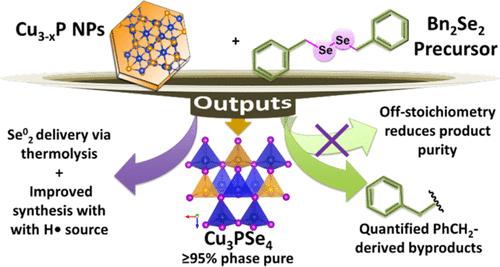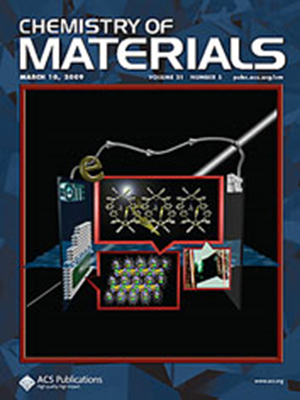Dibenzyl Diselenide as a Monitorable, Atom-Efficient Se Source for the Synthesis of Cu3PSe4 Nanoparticles
IF 7.2
2区 材料科学
Q2 CHEMISTRY, PHYSICAL
引用次数: 0
Abstract
Complex ternary composition nanoparticles (NPs) are highly desired for a range of potential applications, but their syntheses often rely on empirical syntheses rather than designed, ideally mechanism-based, syntheses. Here, we focus on colloidal Cu3PSe4 nanoparticles as a model system, one we have previously prepared from Cu3–xP and solid Se. However, in that prior system quantitatively following the conversion of solid Se into the Cu3PSe4 product is problematic, in turn meaning that the balanced reaction stoichiometry and, hence, mechanistic insights remain elusive. Herein, we show that dibenzyl diselenide (Bn2Se2) has considerable utility in the synthesis of Cu3PSe4 NPs. Using Cu3–xP plus 2 equiv of Bn2Se2 yields Cu3PSe4 as the main NP product. The benzyl moiety (PhCH2−), coupled with NMR and gas chromatography–mass spectrometry (GC-MS) handles, establishes that benzyl loss and toluene (PhCH3) gain are a monitorable proxy for net Se02 delivery when the facile, net two H• donor 9,10-dihydroanthracene is added. The experiments performed and the results obtained help to further lay the groundwork for the expanded use of Bn2Se2 as a Se02 delivery reagent for the syntheses of Se-containing materials. More broadly, the results herein support the use of molecular precursors, chosen based on previously established chemistry, that allow trackable, quantifiable reaction products in NP and related material syntheses.

求助全文
约1分钟内获得全文
求助全文
来源期刊

Chemistry of Materials
工程技术-材料科学:综合
CiteScore
14.10
自引率
5.80%
发文量
929
审稿时长
1.5 months
期刊介绍:
The journal Chemistry of Materials focuses on publishing original research at the intersection of materials science and chemistry. The studies published in the journal involve chemistry as a prominent component and explore topics such as the design, synthesis, characterization, processing, understanding, and application of functional or potentially functional materials. The journal covers various areas of interest, including inorganic and organic solid-state chemistry, nanomaterials, biomaterials, thin films and polymers, and composite/hybrid materials. The journal particularly seeks papers that highlight the creation or development of innovative materials with novel optical, electrical, magnetic, catalytic, or mechanical properties. It is essential that manuscripts on these topics have a primary focus on the chemistry of materials and represent a significant advancement compared to prior research. Before external reviews are sought, submitted manuscripts undergo a review process by a minimum of two editors to ensure their appropriateness for the journal and the presence of sufficient evidence of a significant advance that will be of broad interest to the materials chemistry community.
 求助内容:
求助内容: 应助结果提醒方式:
应助结果提醒方式:


